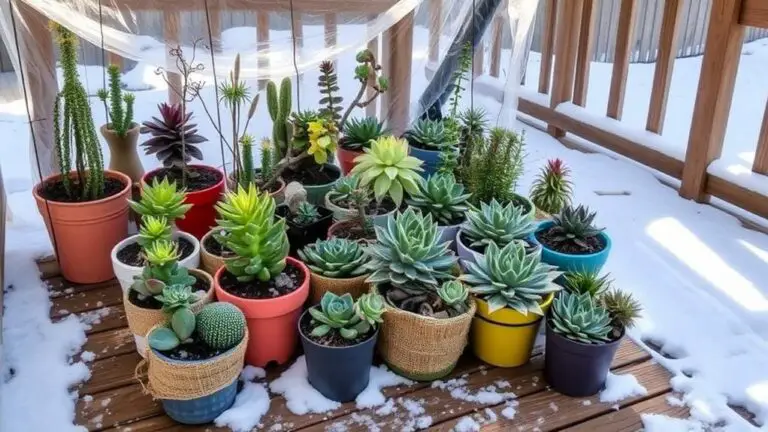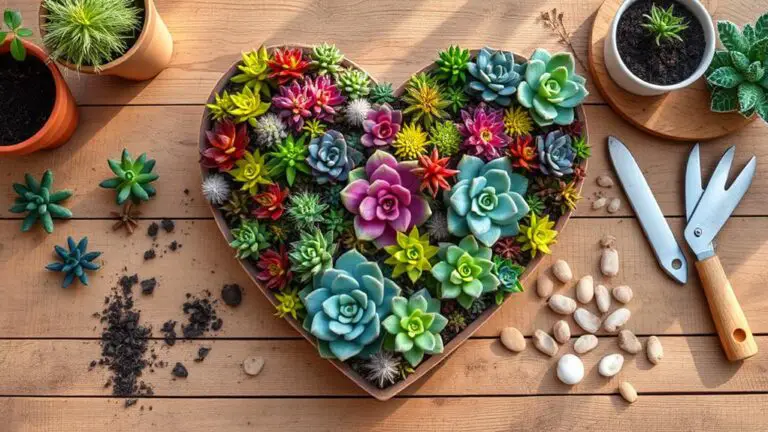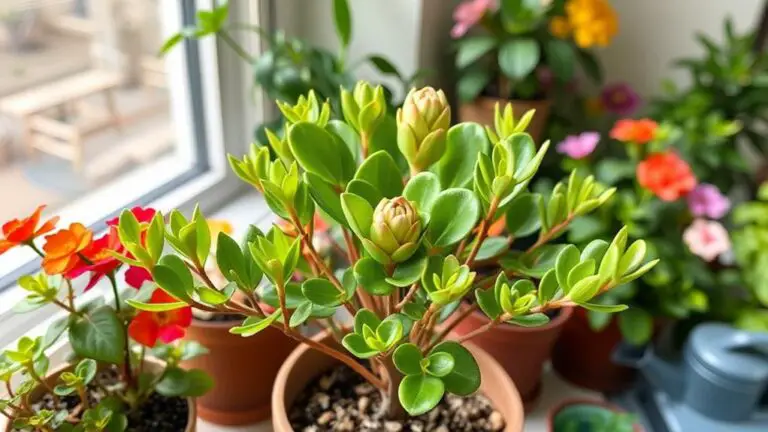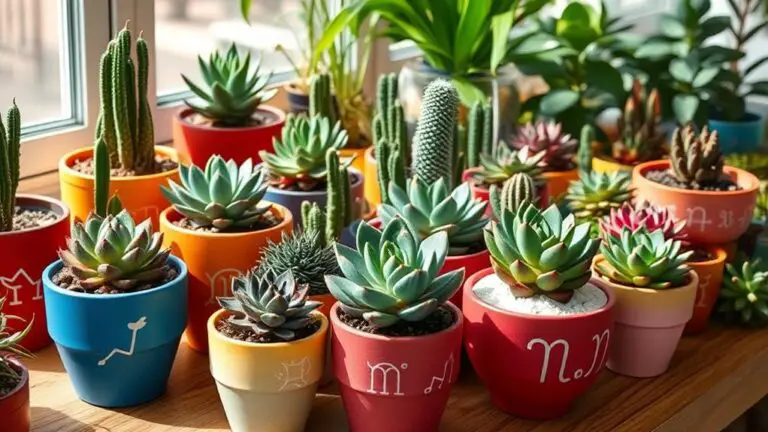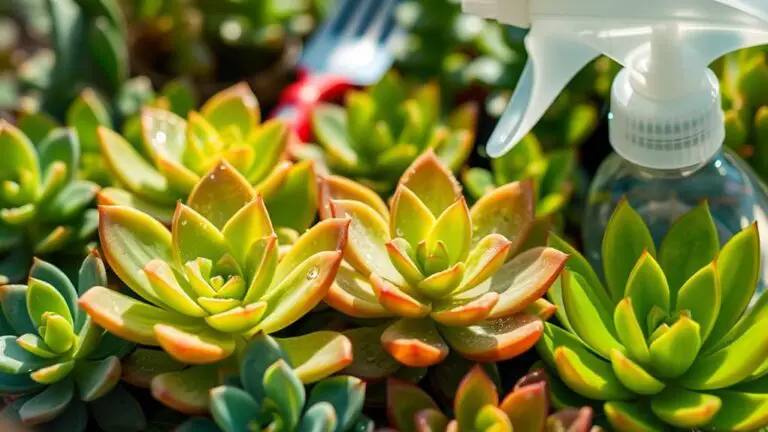10 Mistakes Beginners Make With Succulents
When you first start caring for succulents, it's easy to make a few missteps that can hinder their growth or even cause them to die. For instance, overwatering is a common error that often leads to root rot, and using the wrong type of soil can trap moisture, creating an unhealthy environment. Additionally, many beginners overlook the specific light needs of these plants, resulting in weak, leggy growth. Understanding these pitfalls is essential, but there are more subtle mistakes you might not be aware of. Curious about what else you might be doing wrong?
Overwatering
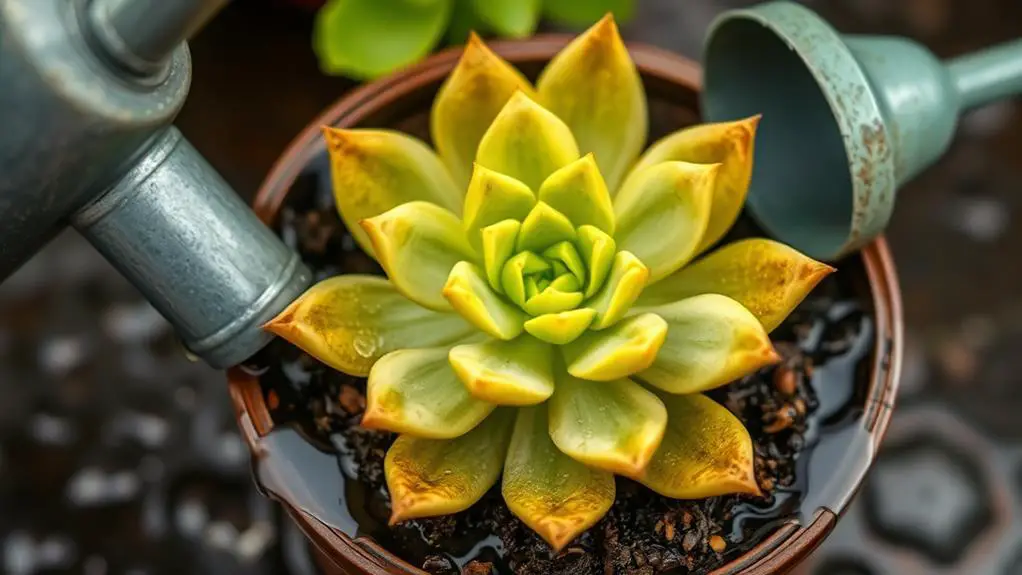
Overwatering is the number one mistake beginners make with succulents, often leading to root rot, which is characterized by mushy, brown roots.
It's easy to think that your succulent needs more water, but these plants are adapted to dry conditions. They don't need to be watered as often as other houseplants. Typically, watering every 2-3 weeks is enough, but always check that the soil is completely dry before watering again.
To avoid overwatering, make sure your pots have adequate drainage holes. These holes let excess water escape, preventing it from sitting at the bottom and causing root rot.
Succulents thrive in well-draining soil. This type of soil doesn't remain waterlogged, which is essential for the health of your plant.
Watch for signs of overwatering like yellowing leaves, a foul smell from the soil, and mold or fungus on the surface. These symptoms indicate that your succulent is getting too much water.
Beginners often mistakenly think succulents need moisture retention, but the truth is they prefer to be dry most of the time.
Poor Soil Choice

Many beginners make the mistake of using regular potting soil for their succulents, which often retains too much moisture and puts your plants at risk of root rot. Succulents need well-draining soil to thrive. Regular potting soil holds onto water, which can cause the roots to rot and damage your plant.
To avoid this, you should choose a soil mix that dries out quickly. A good succulent soil mix usually consists of equal parts potting soil, coarse sand, and perlite or pumice. This combination guarantees that the soil doesn't hold too much moisture and that excess water can escape easily.
Another option is to purchase specialized succulent and cactus soil mixes, which are designed to promote ideal drainage. The type of soil you use directly affects how much moisture remains around the roots of your succulent. A gritty mix is excellent for letting water flow through, preventing root rot.
Repotting your succulents into the right soil can greatly improve their growth and overall health. So, make certain to invest in a well-draining soil mix to give your succulents the best chance to flourish.
Inadequate Drainage
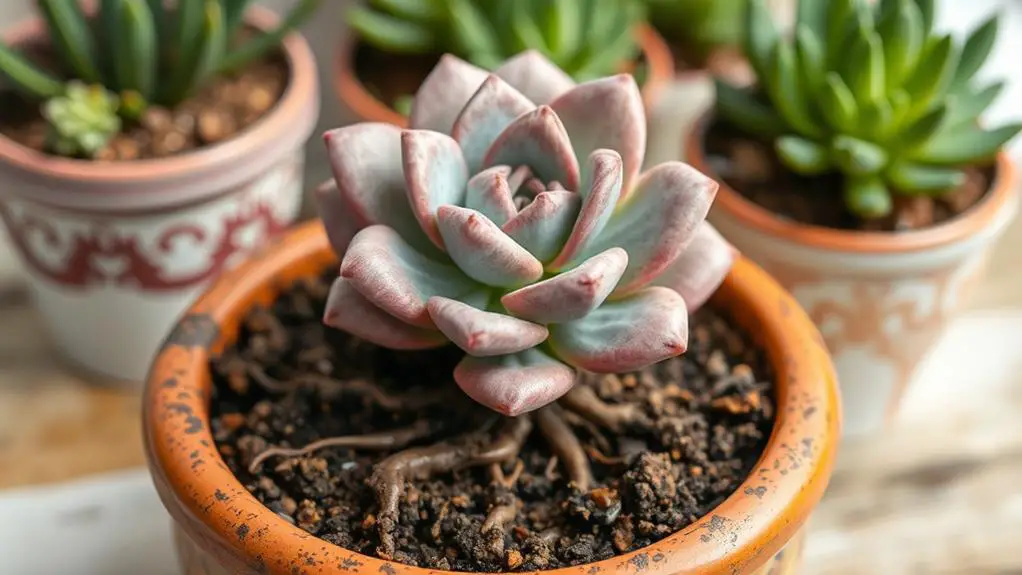
Inadequate drainage is a common pitfall that can quickly harm your succulents. Using containers without drainage holes greatly increases the risk of overwatering. When water pools at the bottom, it leads to root rot, a severe problem for succulents. To prevent this, always choose pots with drainage holes so excess water can escape.
Another mistake is relying on pebble layers to improve drainage. Contrary to popular belief, pebbles can actually make moisture retention worse. Instead, use well-draining soil. A good mix for succulents includes potting soil, coarse sand, and perlite or pumice. This combination helps avoid water accumulation around the roots, keeping your plants healthy.
If you must use a pot without drainage holes, add a layer of gravel or pebbles at the bottom. This can help absorb excess moisture, but it's not a perfect solution. It's still better to use pots with proper drainage.
Regularly check the soil moisture and adjust your watering habits accordingly. Proper drainage and well-draining soil are essential to prevent overwatering and root rot.
Insufficient Light
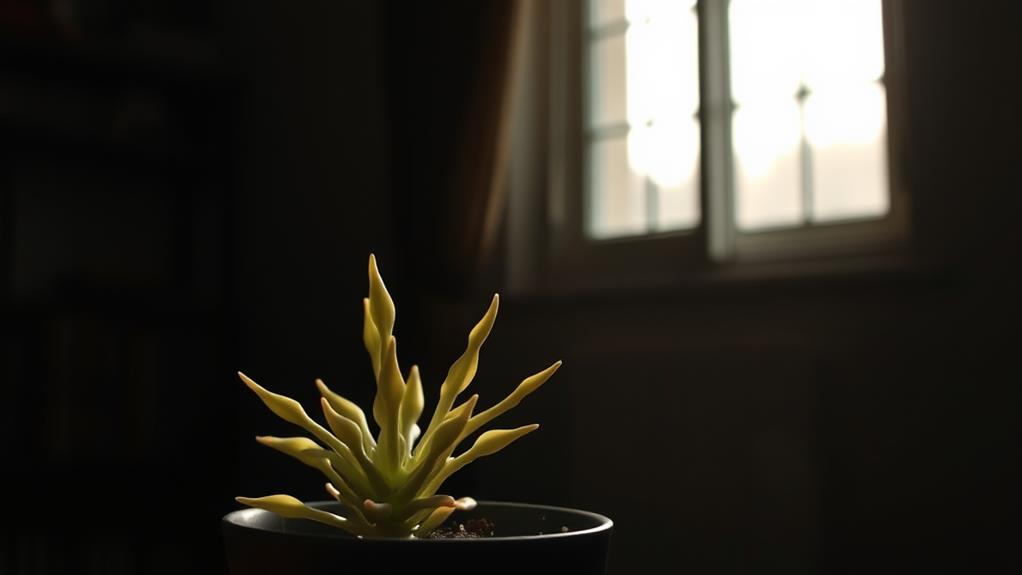
Ensuring your succulents get enough light is essential for their health and appearance.
Most need 6-8 hours of bright, indirect sunlight daily to stay vibrant and avoid becoming leggy.
Place them near south or east-facing windows for the best light, and if that's not possible, consider using grow lights to meet their needs.
Light Exposure Requirements
A common mistake beginners make with succulents isn't providing enough light. Most succulents need at least 6-8 hours of bright, indirect sunlight every day to thrive.
In their natural habitat, they get full sun exposure, so you need to mimic these conditions in your succulent garden. Without enough light, your succulents will start to stretch towards the light source, resulting in weak, leggy growth. This stretching can cause the plants to lose their vibrant colors and become less sturdy.
To prevent this, place your succulents near south or east-facing windows, where they can get the best light conditions. North-facing windows usually don't offer enough intensity.
If you find that natural light is limited in your home, consider using grow lights to supplement it. This way, your succulents will receive the necessary light for healthy growth.
Effects of Low Light
When succulents don't get enough light, you'll quickly notice changes in their appearance and health. Succulents need at least 6-8 hours of bright, indirect sunlight daily to thrive. Without enough light, they become leggy, stretching out and losing their compact form. Their vibrant colors fade, turning pale as they reach for insufficient light sources.
Here's a quick guide to the effects of low light on succulents:
| Symptom | Description |
|---|---|
| Leggy Growth | Stems stretch out, become spindly |
| Loss of Color | Leaves turn pale or lose vibrancy |
| Weak Structure | Plants become fragile, prone to breakage |
| Increased Pests | More susceptible to infestations |
You'll also find that succulents placed in low light conditions are more likely to suffer from diseases. North-facing windows might not provide the light they need. Without enough light, your plants won't be healthy and strong. Remember, a healthy succulent is one that gets the right amount of light.
To guarantee your succulents thrive, monitor their light exposure and adjust their placement as needed. It's all about finding that balance to keep them looking their best.
Optimal Light Sources
Finding the right light source is vital for the health and vibrancy of your succulents. Most succulents need at least 6-8 hours of bright, indirect sunlight daily to thrive. Without enough light, your plants can become leggy, weak, and lose their beautiful colors. This can eventually lead to poor health.
To provide ideal light, place your succulents near south or east-facing windows. These spots typically offer the best natural light conditions for your plants.
However, if your home doesn't get much natural light, don't worry. You can use grow lights designed for plants to supplement their light needs. These lights can help guarantee your succulents get the illumination they require.
Remember, regular assessment is key. Check the light conditions and adjust your plant placement as needed. This can prevent long-term issues related to insufficient light. When your succulents get the right amount of light, they're more likely to thrive and look their best.
In addition to proper lighting, don't forget about water and drainage. Both are essential for keeping your succulents healthy.
Ignoring Dormancy

Ignoring dormancy is a common mistake many beginners make with succulents.
It's important to recognize when your succulents, like aeoniums, are resting, especially during hot summers or cold winters.
Adjusting your care routine to match these dormant periods, such as reducing watering and light, will help keep your plants healthy and happy.
Recognizing Dormant Periods
Understanding the dormancy periods of your succulents is vital for their care and survival. Recognizing when your succulent is dormant helps you avoid common mistakes like overwatering, which can lead to root rot. Many succulents, such as Aeoniums, enter dormancy during hot, dry summers. During this time, they might look dead, but they're just resting. You must adjust your care routines accordingly.
It's important to know that succulents don't need regular watering when they're not actively growing. Overwatering during dormancy is a common error that can harm your plant. Instead, let the soil dry out completely before you water again.
Pay attention to seasonal changes; winter rains often revive dormant succulents, signaling that it's time to resume a more typical watering schedule.
Understanding your plant's native climate and dormancy habits is key. This knowledge will help you provide the best care and extend your succulent's life.
Don't ignore dormancy—it's a natural part of your succulent's cycle. By adapting your care routines to these periods, you'll promote healthier, happier plants. Keep an eye on your succulents, and they'll thrive under your thoughtful care.
Seasonal Care Adjustments
Seasonal care adjustments are vital for the health of your succulents, especially during their dormant periods. When succulents like aeoniums enter dormancy in hot, dry summers, they need less water and care. Ignoring this can lead to overwatering, which harms their healthy root systems. Adjust your watering schedule to reduce the frequency considerably during these times.
Understanding dormancy patterns helps you make the right seasonal adjustments. For instance, certain euphorbias might need more aggressive pruning while dormant. This guarantees they grow better when the cooler seasons return.
Another key adjustment involves fertilization. During dormancy, succulents aren't actively growing and can't use nutrients effectively. Reducing the amount of fertilizer you provide will help prevent nutrient build-up in the soil, which can damage your plants.
Monitoring your succulents for signs of growth resumption as the seasons change is essential. This awareness helps you avoid overwatering and guarantees the roots stay healthy.
Identifying Dormant Symptoms
Recognizing dormant symptoms in your succulents is vital to avoid overwatering and unnecessary care. When succulents like aeoniums enter dormancy during hot, dry summers, they often appear lifeless or dead. This can be confusing, leading you to think your plant needs more water or care. However, understanding dormancy is significant.
Look for signs of dormancy such as shriveling leaves or slowed growth. These are natural indicators that your succulent is taking a break and doesn't need extra water. Overwatering during dormancy can stress the plant and cause root rot, which is often fatal. Instead, trust that your succulent knows what it's doing.
As winter rains approach, dormant succulents like aeoniums will revive and show new growth. This is your cue to adjust your care routine appropriately. By recognizing these patterns, you can prevent unnecessary stress on your plants and guarantee they thrive.
Understanding the natural dormancy patterns of specific succulents helps you provide the right care at the right time. This knowledge keeps your plants healthy and vibrant, allowing you to enjoy their beauty for years to come.
Neglecting Pests
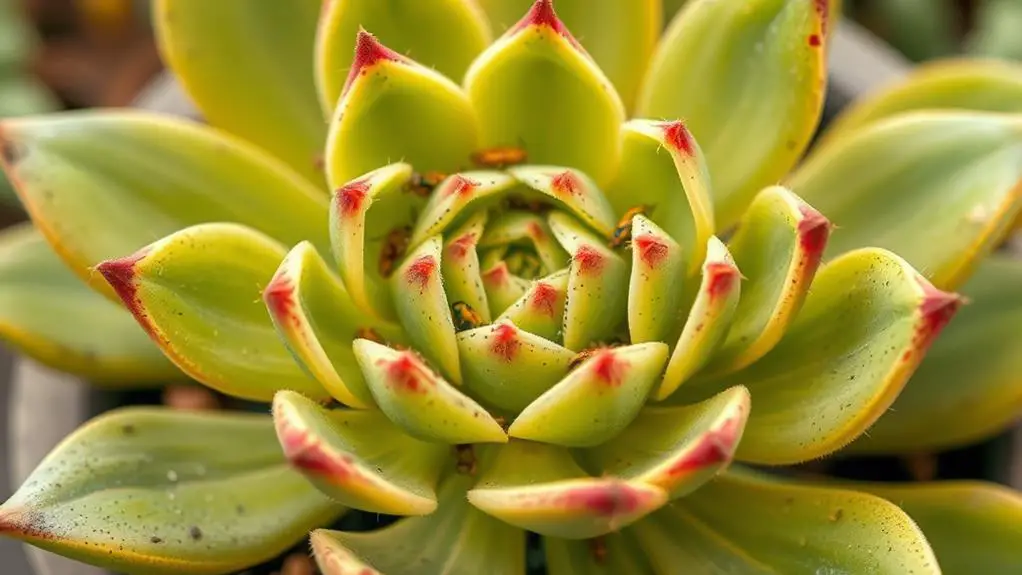
Many beginners make the mistake of neglecting pests, which can quickly turn their succulent-growing experience into a nightmare.
Early detection of pests is essential to prevent damage and keep your succulents healthy. Regular monitoring helps you catch issues like aphids, mealybugs, and cochineal scale before they cause significant harm.
Here are four steps to help you stay on top of pest management:
- Inspect your plants regularly: Look for signs of pests such as discolored leaves or sticky residue. Early detection can stop infestations before they spread.
- Use horticultural soap: For pests like cochineal scale on cacti, especially Opuntia, regular scrubbing with horticultural soap can manage infestations effectively.
- Bait for snails: Snails can cause significant harm, so placing bait early in the season can reduce their population and prevent damage.
- Check for agave snout weevils: This invasive pest targets succulents but regular checks can help you spot them early and take action to save your plants.
Wrong Plant Selection

Choosing the right succulents for your indoor space is key to their success, but it can be tricky.
Some plants, like jade, do well in low light, while others need bright, indirect sunlight for 6-8 hours a day.
Make sure you match your plant's needs with your home's conditions to avoid common mistakes and help your succulents thrive.
Inappropriate Indoor Varieties
Selecting the wrong indoor succulents is a common pitfall for beginners. Many inappropriate indoor varieties struggle due to a lack of enough light. It's crucial to pay attention to the natural light available in your home when choosing succulents. Common mistakes often involve selecting plants that need more light than an indoor environment can provide.
Many succulents, like Echeveria and Sedum, require at least 6-8 hours of bright, indirect sunlight daily. Without enough light, these plants can go weak and leggy. Instead, consider varieties like Haworthia and Gasteria, which are more tolerant of indoor conditions. Aloe vera also adapts well to indoor settings.
To avoid these issues, follow these steps:
- Assess Your Light: Determine how much natural light your space gets daily.
- Research Plant Needs: Look up specific light requirements for different succulents.
- Choose Wisely: Select varieties known to thrive indoors, like Haworthia.
- Monitor Growth: Keep an eye on your plants and adjust their placement if needed.
Water Requirements Mismatch
While picking the right indoor variety helps, understanding and matching the water requirements of your succulents is just as significant. Many beginners mistakenly choose succulents with varying water needs, leading to either overwatering or underwatering. This can harm both drought-tolerant and moisture-loving plants.
It's vital to research the specific water needs of each succulent species you own. For instance, jade plants (Crassula ovata) prefer to dry out completely between waterings. In contrast, aloe vera can tolerate slightly more moisture without suffering. Understanding these differences helps you avoid mismatched watering routines.
When creating a mixed succulent arrangement, it's important to group plants with similar water requirements. This guarantees that all your succulents thrive harmoniously.
For example, fat-leaved succulents typically need less water than thin-leaved varieties. Mixing them up can lead to overwatering some and underwatering others.
Light Needs Misjudgment
Many beginners make the mistake of misjudging the light needs of their succulents, often picking plants that require more sunlight than their indoor conditions can provide. This can lead to leggy growth and loss of color.
To avoid this, it's vital to select succulent varieties that thrive in low-light environments. Snake plants and jade plants are excellent choices for spaces with limited natural light.
Here are some important points to keep in mind:
- Read plant tags carefully: They provide essential information about light requirements.
- Aim for 6-8 hours of bright, indirect sunlight: Most succulents need this for healthy growth.
- Consider grow lights: If your space lacks natural light, grow lights can help provide the necessary exposure.
- Ensure proper drainage: Allow water to drain well to prevent root rot.
Overcrowding
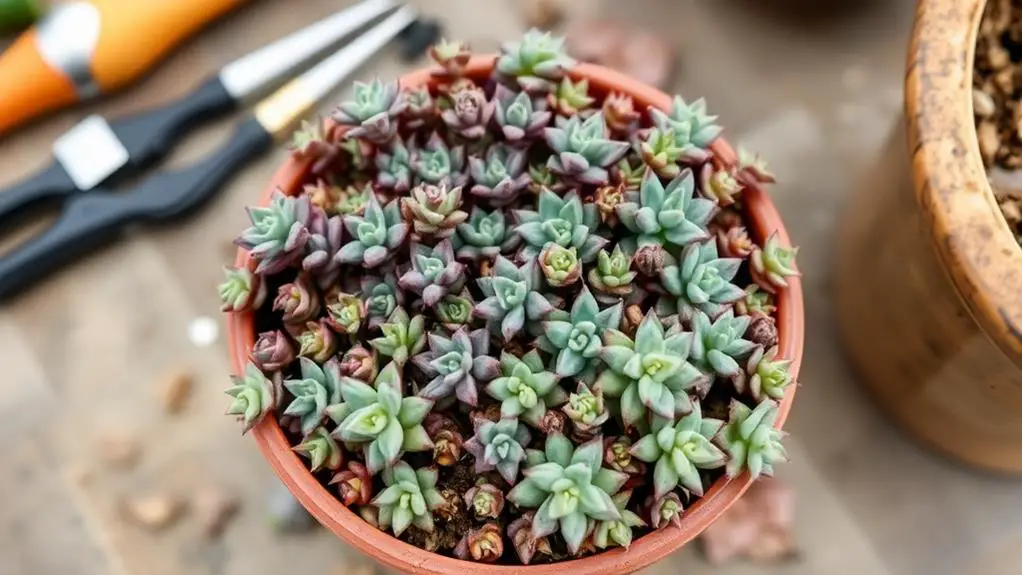
One common mistake beginners make with succulents is overcrowding them in their pots or garden spaces. When you plant succulents too closely, they compete for space, nutrients, and water. This competition can lead to stunted growth and poor health. Each succulent needs its own room to thrive, so giving them adequate space is vital.
Overcrowding also reduces airflow around your plants, increasing the risk of diseases and pest infestations. Good airflow is essential for keeping your succulents healthy. To avoid these problems, make sure to space your plants according to their mature size. Smaller succulents usually need at least 2-4 inches between them. Larger varieties might need even more room.
Proper spacing not only benefits the health and growth of your succulents but also enhances the visual appeal of your garden. When each plant has enough space, you can appreciate their unique shapes and textures. This makes your garden look more organized and attractive.
Improper Pruning
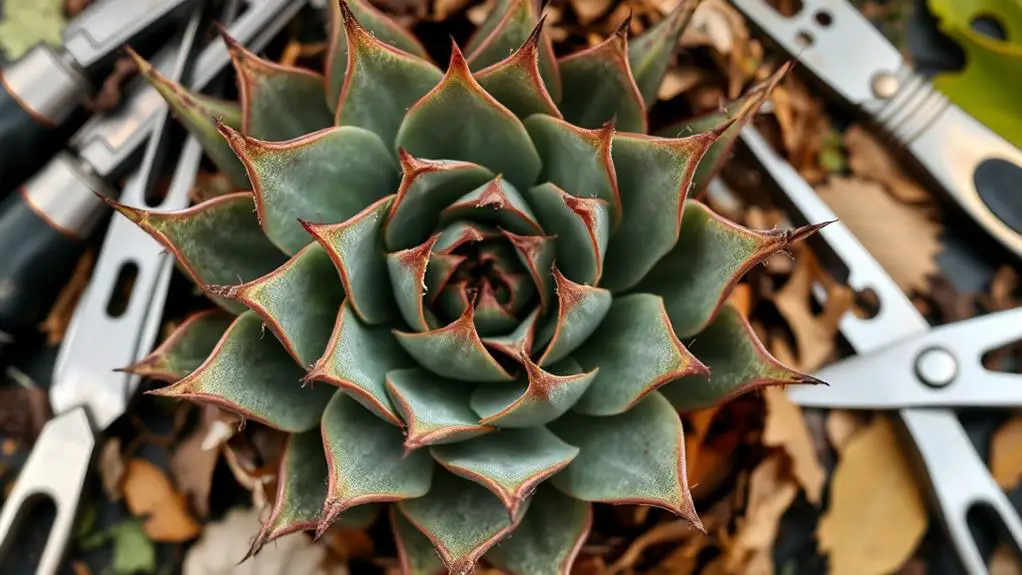
After guaranteeing your succulents have enough space to thrive, the next step to a healthy garden is proper pruning. Improper pruning can stress the plant, affecting its growth. Avoid cutting too much foliage or removing healthy leaves. For example, Aeoniums benefit from regular pruning to rejuvenate leggy growth. Without it, they develop unsightly, elongated stems.
Using the right tools is essential. Always use sharp, clean pruning shears to avoid ragged cuts that can make succulents more susceptible to disease. Euphorbias, in particular, require careful pruning to maintain their shape and health. Their sap can irritate skin and eyes, so take protective measures.
Proper pruning involves:
- Seasonal maintenance: Prune at the right time to prevent overgrowth and guarantee good airflow.
- Sharp pruning shears: Always use clean, sharp tools.
- Selective cutting: Remove only the necessary parts, leaving healthy leaves intact.
- Protect yourself: Wear gloves and eye protection when dealing with plants like Euphorbias.
Frost Damage
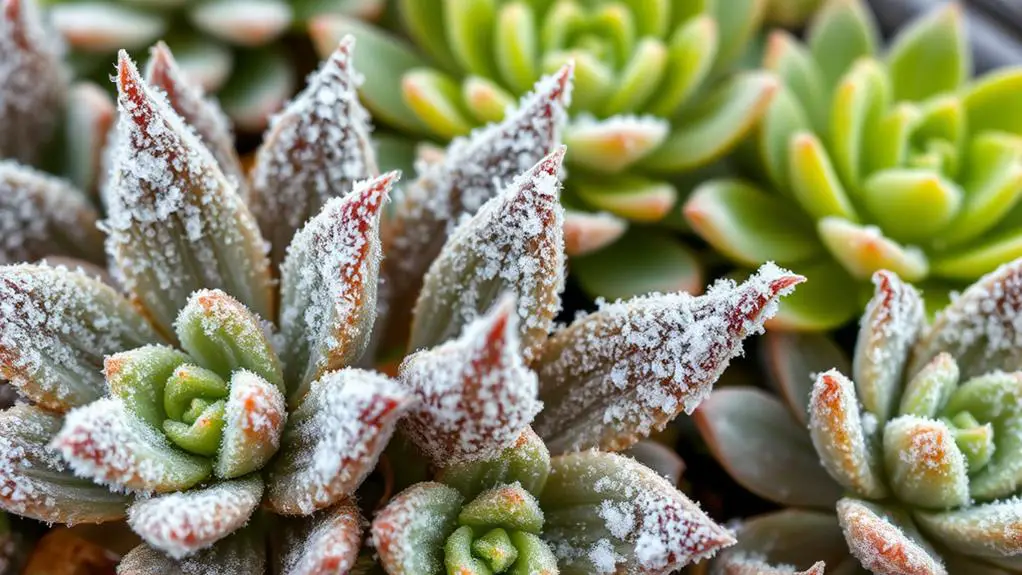
Frost can wreak havoc on your succulents, causing tissue collapse and discoloration that may lead to plant death if not promptly addressed. Many succulents are native to warmer climates and have high frost sensitivity. This means they're not built to withstand freezing temperatures.
To protect your plants, consider using frost cloths or bringing your succulents indoors during cold snaps. It's also essential to think about where you place your plants. More sensitive varieties should be in warmer spots in your garden.
Regularly monitoring weather forecasts during the winter months allows you to take proactive care steps. This way, you can minimize frost exposure and the resulting damage to your precious succulents.
Here's a quick reference table to help you:
| Issue | Solution |
|---|---|
| Tissue Collapse | Move indoors, use frost cloth |
| Discoloration | Increase sunlight exposure |
| High Frost Sensitivity | Choose warmer microclimates |
| Cold Snaps | Monitor forecasts, act early |
| Placement | Prioritize shelter |
Frequently Asked Questions
What Not to Do With Succulents?
Don't overwater your succulents; wait until the soil is dry. Avoid containers without drainage holes. Don't mist them; soak the soil. Confirm they get 6-8 hours of bright, indirect sunlight. Avoid overcrowding them with other plants.
What Is the Trick to Succulents?
The trick to succulents is simple: use well-draining soil, give them 6-8 hours of bright, indirect light daily, and let the soil dry out completely between waterings. Always use pots with drainage holes to prevent root rot.
Why Shouldn't You Touch Succulents?
You shouldn't touch succulents because oils from your skin can cause fungal infections, and frequent handling stresses the plants. Some succulents have irritating sap or spines, and unwashed hands can transfer pests and pathogens to them.
Are Succulents Good for Beginners?
Yes, succulents are great for beginners. They require minimal care, can thrive with less frequent watering, and come in various resilient species. You'll find them easy to maintain, making them perfect for novice gardeners.
Conclusion
You've got this! By avoiding these common mistakes, your succulents will thrive. Remember, don't overwater them, use well-draining soil, and guarantee they get enough light. Pay attention to their dormancy periods and choose the right plants for your environment. Give each plant enough space to grow, prune carefully, and protect them from frost. With a little care and attention, your succulents will flourish, bringing beauty and joy to your home. Happy gardening!


